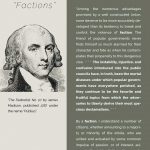Last Updated on October 3, 2021 by Constitutional Militia
It is frustrating for me to respond to Timothy Baldwin’s “A CONCURRING OPINION FOR SECESSION (Part 4 of 12)”, because Mr. Baldwin insists on presenting the issue as “whether the states voluntarily assented to a federal compact or whether the whole people created a perpetual federal government at the exclusion of the state’s right to secede”. Whereas, I am willing to accept for purposes of argument that the States did “assent[ ] to a federal compact” that did not “create[ ] a perpetual federal government”, but instead did (and still does) allow for an individual State to “secede”, but only under a constitutionally specified procedure in which the other States have a right to participate. So I am left in the position of being saddled with arguments which I reject, and which I consider largely irrelevant. In any event—
1. Mr. Baldwin’s emphasis on the language of certain States’ ratifications of the Constitution misses the point. That Delaware, Pennsylvania, Connecticut, and Massachusetts—or every State, for that matter—explicitly “assented to” the Constitution in their ratifications adds nothing to their explicit use of the term “ratified” or “ratify” contained in the same documents. Indeed, the extra language could rightly be construed to be without any effect, and mere surplusage, insofar as the Constitution itself sought only the States’ “Ratification[s]”. Article VII. In any event, when those States “assented to” the Constitution, they “assented to” its terms as they were written, not to some other, unstated terms.
2. In a similarly confusing vein, Mr. Baldwin suggests that the use by Pennsylvania, Connecticut, and Massachusetts of the phrase “Constitution for the United States of America” is somehow significant. I doubt it. The Constitution employs the term “the United States of America” to refer to the new political entity it created. In contradistinction to this, it uses the terms “State”, “States”, and “the several States” to refer to the individual States that pre-existed the United States of America. So, of course these States ratified the Constitution “for the United States of America”. They certainly did not ratify the Constitution for themselves individually. Instead, they retained their own State constitutions (or in the case of Rhode Island her original charter).
3. Mr. Baldwin then quotes Founding Father Roger Sherman as stating that “[t]his Constitution does not attempt to coerce Sovereign bodies, States, in their political capacity”. I have no idea exactly what Sherman had in mind by that statement. But if he meant that the Constitution does not take away from the States certain of their pre-existent sovereign powers, he obviously did not read Article I, § 10 of the document, which most assuredly does “coerce Sovereign bodies, States, in their political capacity” to the extent of the disabilities it imposes on them. (Inasmuch as Sherman doubtlessly did read the Constitution, I must conclude that Mr. Baldwin is misreading Sherman.) Or does Mr. Baldwin contend that, from the moment of their ratifications and even unto today the States could and still can simply disregard those disabilities ad libitum, as one aspect of their supposed “right to secede”, and that the General Government could and can do nothing about such (mis)behavior? If so, for example, can the States today “enter into any Treaty, Alliance, or Confederation”, or “coin Money”, or “emit Bills of Credit” (that is, paper currency)? If not, why not? After all, these are among the powers of independent, sovereign bodies-politic that the States exercised at one time.
4. Mr. Baldwin complains that “[i]f States may not nullify, resist or in any way contradict the federal government except through the US S Ct or alternatively through three-fourth of the States” then Sherman “advocated a very erroneous and even fraudulent proposition to his people”. But who contends that the States may not “resist or in any way contradict the federal government except through the US S Ct or alternatively through three-fourth of the States”? Not I. If Mr. Baldwin means by “nullify” that a State can simply refuse to recognize (say) a statute passed by Congress that conforms in every way to constitutional requirements, then I certainly do deny such State authority. And so does the Constitution. Article VI, cl. 2. On the other hand, a State surely can refuse to recognize a purported “statute” enacted by Congress, or action by the President, or opinion of the Supreme Court that does not conform to the Constitution. Indeed, her officials must do so in fulfillment of their “Oath[s] or Affirmation[s], to support th[e] Constitution”. Article VI, cl. 3. Such a refusal, though, I should term “interposition”, rather than “nullification”, because an unconstitutional “statute”, action, or opinion is null and void even without any State’s so declaring. A right and power of “interposition” does not imply a right and power of “secession”, however. Quite the contrary: “Interposition” is State action within the Union for the purpose of enforcing the Constitution; whereas “secession” is State action designed to take the State outside of the Union for the purpose of ending the application of the Constitution to that State. Self-evidently, contrary to Mr. Baldwin’s assertion, these two diametrically opposed courses of action do not—indeed, cannot possibly in the light of reason— proceed “[u]pon the same basis”, legally or logically.
5. Mr. Baldwin’s invocation of Virginia’s ratification is particularly telling, albeit not in a way congenial to his thesis. As he quotes it,
the powers granted under the Constitution, being derived from the people of the United States, may be resumed by them, whensoever the same shall be perverted to their injury or oppression, and that every power not granted thereby remains with them, and at their will[.]
Plainly, in this passage Virginia was not referring to “the people” of Virginia alone, or to “the people” of any particular State alone, but (as she explicitly recited) to “the people of the United States” as a whole. And so for the words “them” and “their”. Virginia’s concern was not to secure a “right to secede” on the part of herself or any other single State, but to express her belief that “the people of the United States” as a whole had not surrendered, through the Constitution, their authority in some manner to “resume[ ]” all of the powers of government that they had delegated to the General Government. And in this, of course, Virginia was quite correct. See, e.g., Article V. Thus, Mr. Baldwin is obviously incorrect when he (mis)interprets this passage as claiming an authority in a single State to “recall those powers * * * with or without any other state’s consent”. Nothing in this passage applies to a single State alone.
Even less defensible is his conclusion that, “[t]o deny this right, authority and power of a state to unmake the constitution that it alone formed for its body-politic is one of the most egregious and unconscionable acts that could be done against a state”. For Virginia did not claim that “a State” could “unmake the constitution” unilaterally, because she did not claim that she, or any other State, “alone formed [the Constitution] for [her] body-politic”. Virginia knew full well, and plainly stated, that all of the States—in the persons of “the people of the United States”—formed the Constitution, just as its Preamble attests.
6. Finally, Mr. Baldwin argues that the States were not acting as one body-politic with the other states. The US Constitution confirms this by requiring only 9 of the 13 states to ratify. If “one nation” existed, why did Congress allow four of the states to abandon the union at that time? After all, the Articles of Confederation expressly stated that it was “perpetual,” yet four states were allowed to secede by not rejoining the union? This contradicts the assertion (made by Lincoln and other unionists) that the states were never sovereign and independent. This is pure nonsense. Indeed, the remaining four states could act as their desired independently of all other states, because each state acted for itself as a sovereign state.
Now, I refuse to assume any responsibility for what “Lincoln and other unionists” may have said. But the Preamble to the Constitution does refer to one of its purposes as being “to form a more perfect Union”, so obviously a “Union” already did exist before the Constitution was ratified. The Articles of Confederation, which established this earlier Union, did call it “perpetual”; but the Articles also allowed for that Union’s dissolution upon the action of all of the States’ legislatures. See Article XIII. The Constitution was ratified, however, not by the States’ legislatures, but by State “Conventions”, which exercised more power than did legislatures—and had to do so, inasmuch as the Constitution withdrew from the States several of their sovereign powers. So, it was certainly possible for all of the States to remain technically bound by the Articles of Confederation, and within its Union, even while some of them were ratifying the Constitution and thereby seeking “to form a more perfect Union”.
That is, throughout the process, it was certainly possible that none of the States was ever outside of the original Union. Of course, after all of the States ratified the Constitution, the Articles of Confederation (and the Union it created) must simply have dissolved, even without explicit action by the several States’ legislatures, because the Articles’ provisions and the provisions of the Constitutional were mutually incompatible, and the Constitution’s provisions were legally superior to those of the Articles, having been enacted by the States’ “Conventions”, not simply their legislatures. Thus, it is perfectly plausible to conclude that no State ever “seceded” from the Union established by the Articles; rather, that Union simply disappeared by the implicit operation of the Constitution. To be sure, if only nine States had ratified the Constitution, and four States had held fast to the Articles and demanded that the other nine do so as well under Article XIII, an interesting legal problem would have arisen, because of the Articles’ requirement of unanimity among the States for any change in the Articles’ terms. But because that split did not occur, we shall never know how the Founders would have resolved it.
7. In sum, Mr. Baldwin could be correct in his premises that: (i) the States were independent and sovereign entities before they formed their Unions in the Articles of Confederation and then the Constitution; and (ii) the States as bodies-politic “assented” to the Constitution “for the United States of America”. But neither nor both of those premises compels, or even supports, his conclusion that, after having formed the Articles or the Constitution, each of the States still enjoyed an unilateral “right to secede” from either of those “compacts” at her own discretion, and without the participation of any other State in the process.
Certainly, independent and sovereign entities could have agreed as bodies-politic mutually to limit their independence and sovereignty by renouncing, explicitly or implicitly, any purported “right to secede” from a “compact” among themselves, as part of their “ratification of” or “assent to” such a “compact”. And the only way anyone can determine whether they did so is to examine the terms of their “compact”. For part five of twelve click below.



































